check engine light PEUGEOT 308 2017 Owners Manual
[x] Cancel search | Manufacturer: PEUGEOT, Model Year: 2017, Model line: 308, Model: Peugeot 308 2017Pages: 566, PDF Size: 16.05 MB
Page 165 of 566
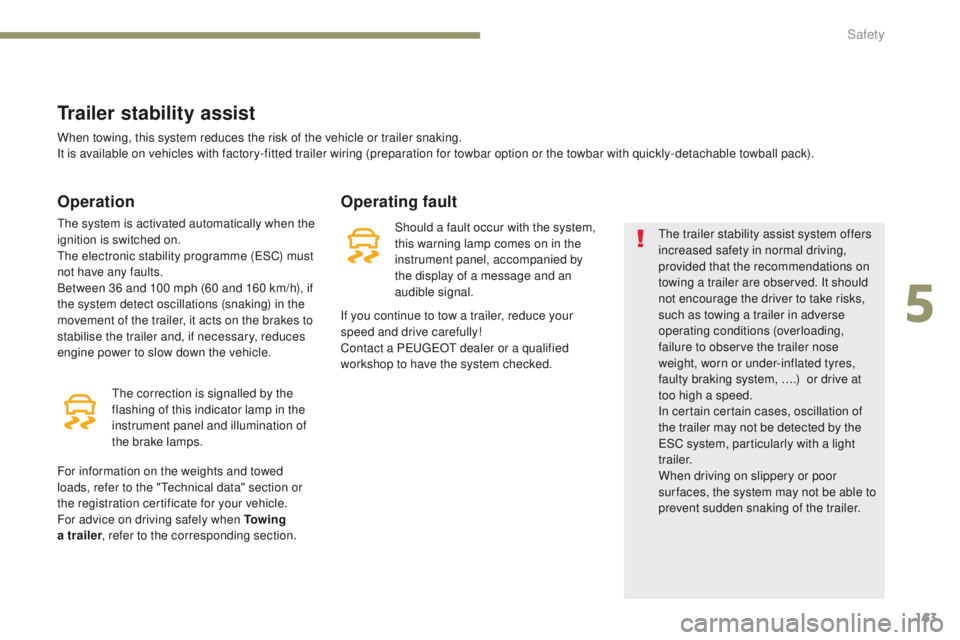
163
3008-2_en_Chap05_securite_ed01-2016
Trailer stability assist
Operation
The system is activated automatically when the
ignition is switched on.
The electronic stability programme (ESC) must
not have any faults.
Between 36 and 100 mph (60 and 160 km/h), if
the system detect oscillations (snaking) in the
movement of the trailer, it acts on the brakes to
stabilise the trailer and, if necessary, reduces
engine power to slow down the vehicle.
For information on the weights and towed
loads, refer to the "Technical data" section or
the registration certificate for your vehicle.
For advice on driving safely when To w i n g
a trailer , refer to the corresponding section.
When towing, this system reduces the risk of the vehicle or trailer snaking.
It is available on vehicles with factory-fitted trailer wiring (preparation for towbar option or the towbar with quickly-detachable towball pack).
The correction is signalled by the
flashing of this indicator lamp in the
instrument panel and illumination of
the brake lamps.
Operating fault
Should a fault occur with the system,
this warning lamp comes on in the
instrument panel, accompanied by
the display of a message and an
audible signal.
If you continue to tow a trailer, reduce your
speed and drive carefully!
Contact a PEUGEOT dealer or a qualified
workshop
to have the system checked. The trailer stability assist system offers
increased safety in normal driving,
provided that the recommendations on
towing a trailer are observed. It should
not encourage the driver to take risks,
such as towing a trailer in adverse
operating conditions (overloading,
failure to observe the trailer nose
weight, worn or under-inflated tyres,
faulty braking system, ….)
or drive at
too high a speed.
In certain certain cases, oscillation of
the trailer may not be detected by the
ESC system, particularly with a light
t r a i l e r.
When driving on slippery or poor
sur faces, the system may not be able to
prevent sudden snaking of the trailer.
5
Safety
Page 198 of 566
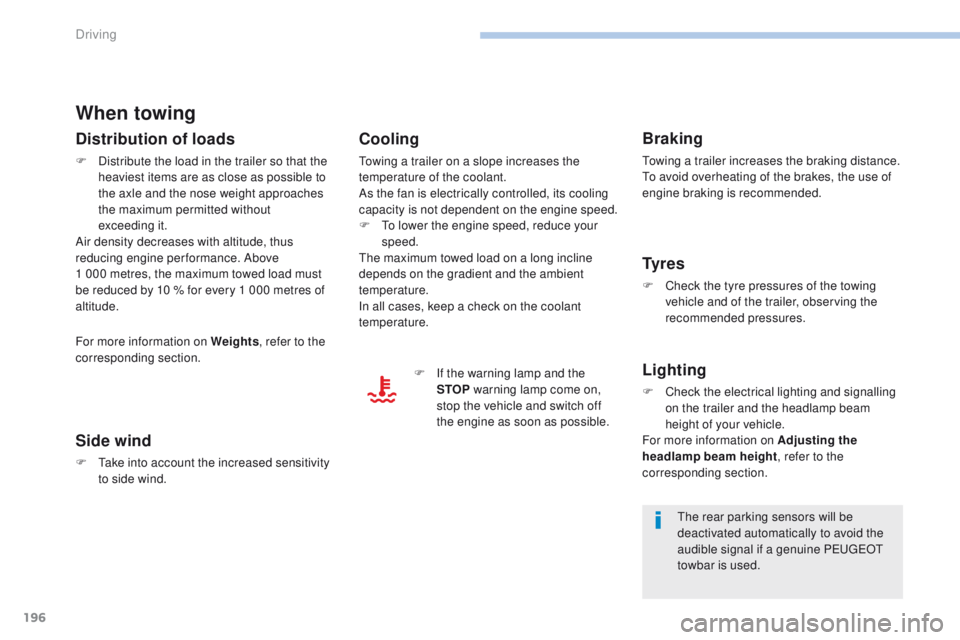
196
3008-2_en_Chap06_conduite_ed01-2016
When towing
Distribution of loads
F Distribute the load in the trailer so that the heaviest items are as close as possible to
the axle and the nose weight approaches
the maximum permitted without
exceeding
it.
Air density decreases with altitude, thus
reducing engine performance. Above
1
000 metres, the maximum towed load must
be reduced by 10
% for every 1 000 metres of
altitude.
Side wind
F Take into account the increased sensitivity to side wind.
For more information on Weights
, refer to the
corresponding section. F
I
f the warning lamp and the
STOP warning lamp come on,
stop the vehicle and switch off
the engine as soon as possible.
Braking
Towing a trailer increases the braking distance.
To avoid overheating of the brakes, the use of
engine braking is recommended.
Ty r e s
F Check the tyre pressures of the towing vehicle and of the trailer, observing the
recommended pressures.
Lighting
F Check the electrical lighting and signalling on the trailer and the headlamp beam
height of your vehicle.
For more information on Adjusting the
headlamp beam height , refer to the
corresponding section.
The rear parking sensors will be
deactivated automatically to avoid the
audible signal if a genuine PEUGEOT
towbar is used.
Cooling
Towing a trailer on a slope increases the
temperature of the coolant.
As the fan is electrically controlled, its cooling
capacity is not dependent on the engine speed.
F
T
o lower the engine speed, reduce your
speed.
The maximum towed load on a long incline
depends on the gradient and the ambient
temperature.
In all cases, keep a check on the coolant
temperature.
Driving
Page 253 of 566
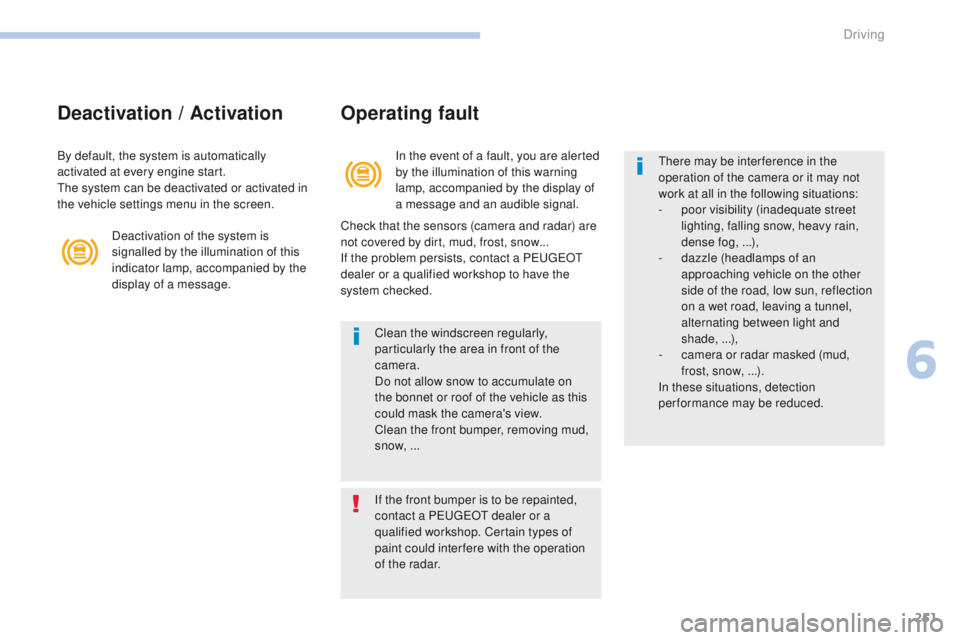
251
3008-2_en_Chap06_conduite_ed01-2016
Deactivation / ActivationOperating fault
In the event of a fault, you are alerted
by the illumination of this warning
lamp, accompanied by the display of
a message and an audible signal.
Clean the windscreen regularly,
particularly the area in front of the
camera.
Do not allow snow to accumulate on
the bonnet or roof of the vehicle as this
could mask the camera's view.
Clean the front bumper, removing mud,
snow, ...
If the front bumper is to be repainted,
contact a PEUGEOT dealer or a
qualified workshop. Certain types of
paint could inter fere with the operation
of the radar.
Check that the sensors (camera and radar) are
not covered by dirt, mud, frost, snow...
If the problem persists, contact a PEUGEOT
dealer or a qualified workshop to have the
system checked.
By default, the system is automatically
activated at every engine start.
The system can be deactivated or activated in
the vehicle settings menu in the screen.
Deactivation of the system is
signalled by the illumination of this
indicator lamp, accompanied by the
display of a message. There may be interference in the
operation of the camera or it may not
work at all in the following situations:
-
p
oor visibility (inadequate street
lighting, falling snow, heavy rain,
dense fog, ...),
-
d
azzle (headlamps of an
approaching vehicle on the other
side of the road, low sun, reflection
on a wet road, leaving a tunnel,
alternating between light and
shade, ...),
-
c
amera or radar masked (mud,
frost, snow, ...).
In these situations, detection
performance may be reduced.
6
Driving
Page 335 of 566

333
3008-2_en_Chap08_en cas-de-panne_ed01-2016
Starting using another battery
F Start the engine of the vehicle with the good battery and leave it running for a
few
minutes.
F
O
perate the starter on the broken down
vehicle and let the engine run.
I
f the engine does not start straight away,
switch off the ignition and wait a few
moments before trying again.
F
W
ait until the engine returns to idle then
disconnect the jump lead cables in the
reverse order.
F
R
efit the plastic cover to the (+) terminal,
if
your vehicle has one.
F
A
llow the engine to run for at least
30
minutes, by driving or with the vehicle
stationary, so that the battery reaches an
adequate state of charge.
When your vehicle's battery is discharged, the
engine can be started using a slave battery
(external or on another vehicle) and jump lead
cables or a battery booster.
Never try to start the engine by
connecting a battery charger.
Never use a 24 V or higher battery
b o o s t e r.
First check that the slave battery has a
nominal voltage of 12 V and a capacity
at least equal to that of the discharged
battery.
The two vehicles must not be in contact
with each other.
Switch off the electrical consumers on
both vehicles (audio system, wipers,
lighting, ...).
Ensure that the jump lead cables do
not pass close to moving parts of the
engine (cooling fan, belts, ...).
Do not disconnect the (+) terminal when
the engine is running. F
R
aise the plastic cover on the (+) terminal,
if your vehicle has one.
F
C
onnect the red cable to the positive
terminal (+) of the flat battery A (at
the
metal elbow) then to the positive
terminal
(+) of the slave battery B or the
b o o s t e r.
F
C
onnect one end of the green or black
cable to the negative terminal (-) of the
slave battery B or the booster (or earth
point on the other vehicle).
F
C
onnect the other end of the green or black
cable to the earth point C on the broken
down vehicle. Some functions, including Stop & Start,
are not available if the battery is not
sufficiently charged.
8
In the event of a breakdown
Page 351 of 566
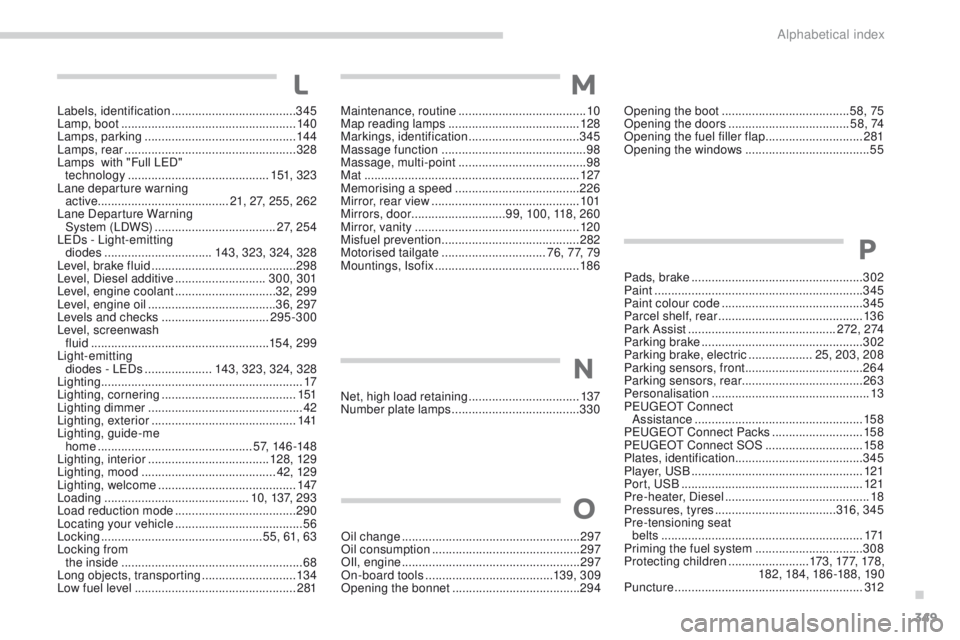
349
3008-2_en_Chap11_index-alpha_ed01-2016
Labels, identification .....................................3 45
Lamp, boot .................................................... 140
Lamps, parking
............................................. 14
4
Lamps, rear
................................................... 328
Lamps with "Full LED" technology
.......................................... 151, 323
Lane departure warning active ....................................... 21, 27 , 255 , 262
Lane Departure Warning System (LDWS)
.................................... 27, 254
LEDs - Light-emitting diodes
................................ 143, 323 , 324, 328
Level, brake fluid
........................................... 29
8
Level, Diesel additive
...........................300, 301
Level, engine coolant
..............................32, 299
Level, engine oil
...............................
.......36, 297
Levels and checks
................................ 295-300
Level, screenwash fluid
..................................................... 15 4, 299
Light-emitting diodes - LEDs
....................14
3, 323 , 324, 328
Lighting
................
............................................ 17
Lighting, cornering
........................................ 151
Lighting dimmer
..............................
................42
Lighting, exterior
...............................
............141
Lighting, guide-me home
.............................................. 57, 146 -148
Lighting, interior
.................................... 128, 129
Lighting, mood
........................................ 42, 129
Lighting, welcome
......................................... 147
Loading
........................................... 10, 137 , 293
Load reduction mode
.................................... 290
Locating your vehicle
...................................... 56
Lo
cking
................................................ 55, 61 , 63
Locking from the inside
...................................................... 68
Long objects, transporting
............................ 13
4
Low fuel level
................................................ 281
L
Maintenance, routine ...................................... 10
Map reading lamps ....................................... 128
Markings, identification
.................................345
Massage function
........................................... 98
Massage, multi-point
...................................... 98
Mat
................................................................ 127
Memorising a speed
..................................... 226
Mirror, rear view
............................................ 101
Mirrors, door ............................ 99, 10 0 , 118, 260
Mirror, vanity
..............................
...................120
Misfuel prevention
...............................
..........282
Motorised tailgate
............................... 76, 77 , 79
Mountings, Isofix
........................................... 18 6
M
Net, high load retaining .................................137
Number plate lamps ...................................... 33
0
N
Opening the boot ......................................58, 75
Opening the doors ............................... .....58, 74
Opening the fuel filler flap
.............................281
Opening the windows
..................................... 55
Pads, brake
................................................... 302
Paint
.............................................................. 345
Paint colour code
.......................................... 345
Parcel shelf, rear
........................................... 13
6
Park Assist
............................................ 272, 2 74
Parking brake
................................................ 302
Parking brake, electric
...................25, 203 , 208
Parking sensors, front
...................................264
Parking sensors, rear .................................... 263
Personalisation
...............................
................13
P
E
UGEOT
C
onnect
Assistance
.................................................. 15
8
P
E
UGEOT
C
onnect Packs
...........................15 8
P
E
UGEOT
C
onnect SOS
............................. 15
8
Plates, identification ...................................... 345
Player, USB
................................................... 121
Port, USB
...................................................... 12
1
Pre-heater, Diesel
........................................... 18
Pressures, tyres
.................................... 316, 345
Pre-tensioning seat belts
..............................
..............................171
Priming the fuel system
................................308
Protecting children
........................173, 17 7 , 178 ,
182 , 18 4 , 18 6 -188 , 19 0
Puncture
........................................................ 312
P
Oil change ..................................................... 297
Oil consumption ............................................ 297
OIl, engine
..................................................... 297
On-board tools
...................................... 13 9, 309
Opening the bonnet
...................................... 29
4
O
.
Alphabetical index
Page 553 of 566
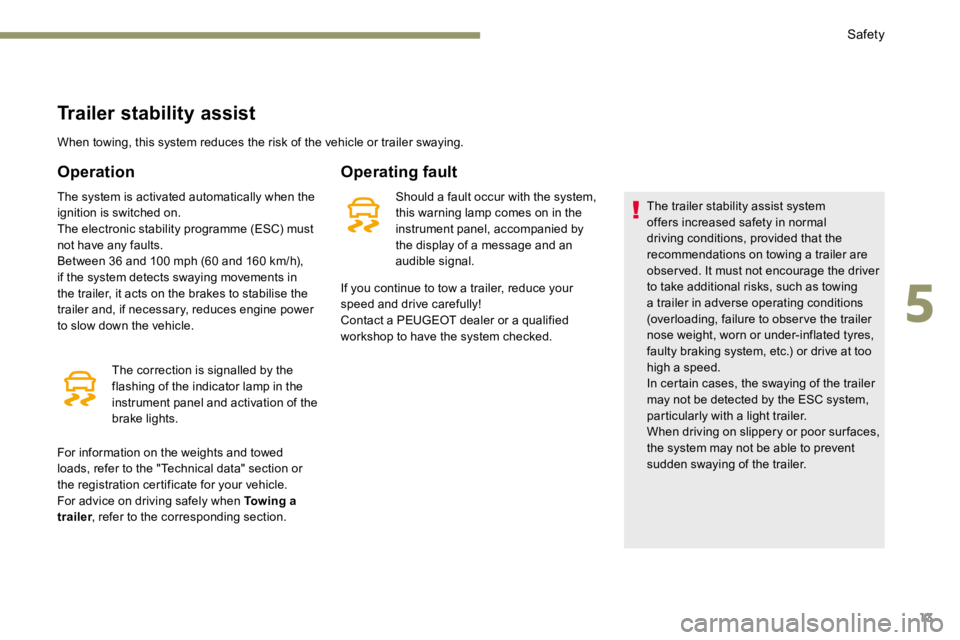
13
Trailer stability assist
When towing, this system reduces the risk of the vehicle or trailer swaying.
Operation
The system is activated automatically when the
ignition is switched on.
The electronic stability programme (ESC) must
not have any faults.
Between 36 and 100 mph (60 and 160 km/h),
if the system detects swaying movements in
the trailer, it acts on the brakes to stabilise the
trailer and, if necessary, reduces engine power
to slow down the vehicle.The correction is signalled by the
flashing of the indicator lamp in the
instrument panel and activation of the
brake lights.
Operating fault
Should a fault occur with the system,
this warning lamp comes on in the
instrument panel, accompanied by
the display of a message and an
audible signal. The trailer stability assist system
offers increased safety in normal
driving conditions, provided that the
recommendations on towing a trailer are
obser ved. It must not encourage the driver
to take additional risks, such as towing
a trailer in adverse operating conditions
(overloading, failure to obser ve the trailer
nose weight, worn or under-inflated tyres,
faulty braking system, etc.) or drive at too
high a speed.
In certain cases, the swaying of the trailer
may not be detected by the ESC system,
particularly with a light trailer.
When driving on slippery or poor sur faces,
the system may not be able to prevent
sudden swaying of the trailer.
If you continue to tow a trailer, reduce your
speed and drive carefully!
Contact a PEUGEOT dealer or a qualified
workshop to have the system checked.
For information on the weights and towed
loads, refer to the "Technical data" section or
the registration certificate for your vehicle.
For advice on driving safely when Towing a
trailer , refer to the corresponding section.
5
Safety
Page 557 of 566
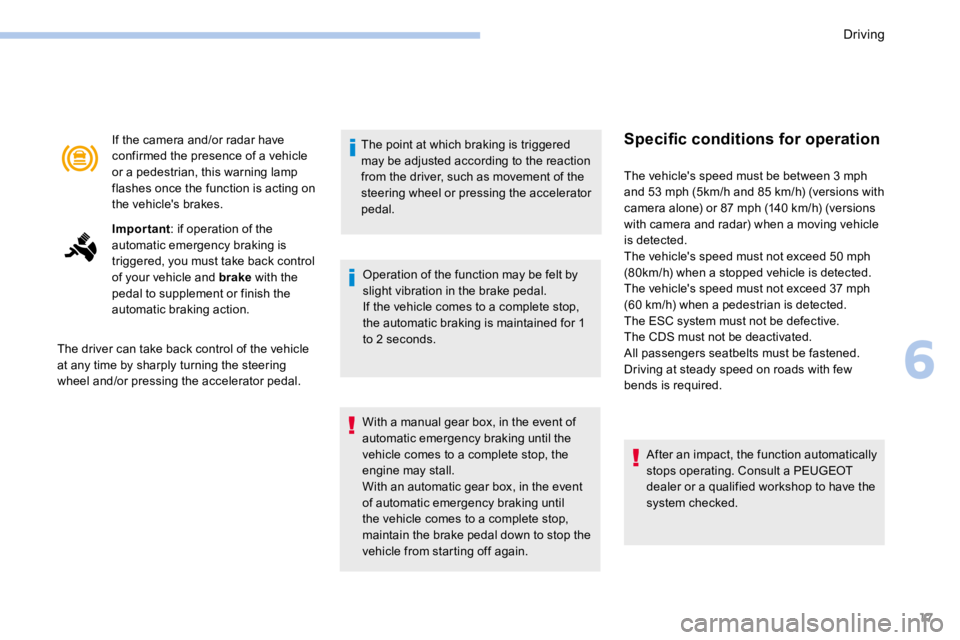
17
If the camera and/or radar have
confirmed the presence of a vehicle
or a pedestrian, this warning lamp
flashes once the function is acting on
the vehicle's brakes.
Important: if operation of the
automatic emergency braking is
triggered, you must take back control
of your vehicle and brake with the
pedal to supplement or finish the
automatic braking action.
The driver can take back control of the vehicle
at any time by sharply turning the steering
wheel and/or pressing the accelerator pedal. The point at which braking is triggered
may be adjusted according to the reaction
from the driver, such as movement of the
steering wheel or pressing the accelerator
pedal.
Operation of the function may be felt by
slight vibration in the brake pedal.
If the vehicle comes to a complete stop,
the automatic braking is maintained for 1
to 2 seconds.
With a manual gear box, in the event of
automatic emergency braking until the
vehicle comes to a complete stop, the
engine may stall.
With an automatic gear box, in the event
of automatic emergency braking until
the vehicle comes to a complete stop,
maintain the brake pedal down to stop the
vehicle from starting off again.Specific conditions for operation
The vehicle's speed must be between 3 mph
and 53 mph (5km/h and 85 km/h) (versions with
camera alone) or 87 mph (140 km/h) (versions
with camera and radar) when a moving vehicle
is detected.
The vehicle's speed must not exceed 50 mph
(80km/h) when a stopped vehicle is detected.
The vehicle's speed must not exceed 37 mph
(60 km/h) when a pedestrian is detected.
The ESC system must not be defective.
The CDS must not be deactivated.
All passengers seatbelts must be fastened.
Driving at steady speed on roads with few
bends is required. After an impact, the function automatically
stops operating. Consult a PEUGEOT
dealer or a qualified workshop to have the
system checked.
6
Driving
Page 558 of 566
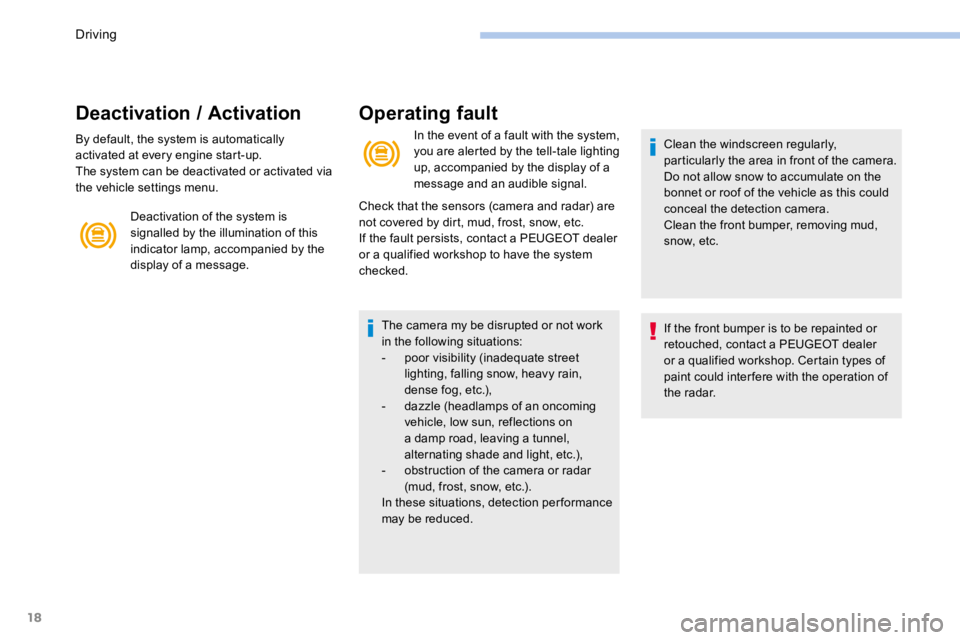
18
Deactivation / Activation
By default, the system is automatically
activated at every engine start-up.
The system can be deactivated or activated via
the vehicle settings menu.Deactivation of the system is
signalled by the illumination of this
indicator lamp, accompanied by the
display of a message. Clean the windscreen regularly,
particularly the area in front of the camera.
Do not allow snow to accumulate on the
bonnet or roof of the vehicle as this could
conceal the detection camera.
Clean the front bumper, removing mud,
snow, etc.
If the front bumper is to be repainted or
retouched, contact a PEUGEOT dealer
or a qualified workshop. Certain types of
paint could inter fere with the operation of
the radar.
Operating fault
Check that the sensors (camera and radar) are
not covered by dirt, mud, frost, snow, etc.
If the fault persists, contact a PEUGEOT dealer
or a qualified workshop to have the system
checked.In the event of a fault with the system,
you are alerted by the tell-tale lighting
up, accompanied by the display of a
message and an audible signal.
The camera my be disrupted or not work
in the following situations:
- poor visibility (inadequate street
lighting, falling snow, heavy rain,
dense fog, etc.),
- dazzle (headlamps of an oncoming
vehicle, low sun, reflections on
a damp road, leaving a tunnel,
alternating shade and light, etc.),
- obstruction of the camera or radar
(mud, frost, snow, etc.).
In these situations, detection performance
may be reduced.
Driving